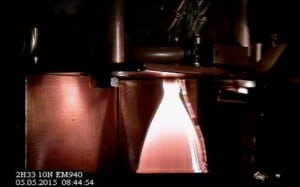Latest News
[Via Satellite 06-22-2015] The European Space Agency (ESA) reported that the agency and industry partner Airbus Defence and Space have completed a series of hot firings of a 3-D printed platinum combustion chamber and nozzle. The firings consisted of 618 ignitions, including a single burn of 32 minutes that reached a maximum throat temperature of 1,253 degrees Celsius.
The purpose of the test was to evaluate alternative manufacturing techniques to reduce costs. Additive manufacturing, or 3-D printing, builds up an object in layers rather than cutting away material from a solid block, resulting in less waste.
ESA and Airbus made the prototype 10 N hydrazine thruster’s combustion chamber from platinum–rhodium alloy using a laser beam applied to a metal powder bed.
Airbus Defence and Space’s facility in Lampoldshausen, Germany, produced and tested the thruster through an ESA project called Additive Manufacturing Technologies for Advanced Satellite Thrust Chamber, AMTAC. The project is part of ESA’s Advanced Research in Telecommunications Systems (ARTES) program. Germany’s Heraeus company supplied the platinum–rhodium, which the Nanoval firm atomized, and the Fraunhofer Institutes of Laser Technology, in Aachen, and Machine Tools and Forming Technology, in Augsburg oversaw the additive manufacturing process.
“Platinum–rhodium was chosen for this first phase as the most mature platinum alloy for additive manufacturing,” said Steffen Beyer of Airbus Defence and Space, who managed the project. “Then, in the next phase, we will attempt to print using a new alloy, platinum–iridium, which has performance advantages. This alloy cannot easily be manufactured by traditional techniques like casting and forging, so printing is the only way it can be harnessed for space use.”
Get the latest Via Satellite news!
Subscribe Now